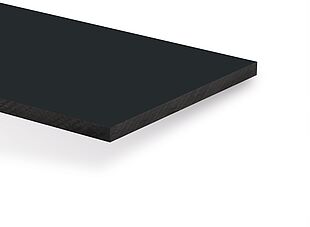Areas of application
For unusual furniture and interior concepts in the home and contract sectors, in leisure and spa facilities, in shop design, in catering, as well as in humid and wet conditions in which particular robustness, durability and high hygienic standards including aesthetics are required of the material. The material is suitable for heavy-duty, horizontal surfaces, open edge solutions as well as for engraving for individual 3D effects.
Certificates & labels
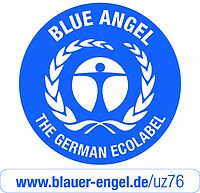
Blue Angel DE-UZ 76
The Blue Angel has been the federal government's eco-label for 40 years. Independent and credible, it sets demanding standards for environmentally friendly products and services. The Blue Angel is the orientation for sustainable purchasing.
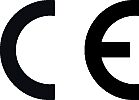
CE conformity
The CE-marking documents that goods comply with the safety and health requirements of the European Union. Its aim is to guarantee safe, flawless and high-quality goods on all European markets.
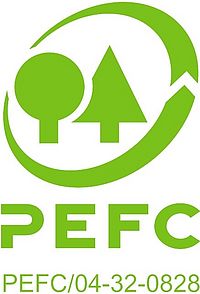
PEFC certified
PEFC is the largest institution for ensuring sustainable forest management through an independent certification system. Wood and wood products with the PEFC seal originate demonstrably from ecologically, economically and socially sustainable forestry.
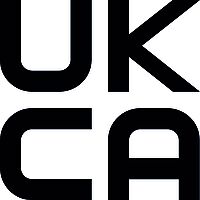
UKCA conformity
The UKCA-marking documents that goods comply with the safety and health requirements of the United Kingdom. Its aim is to guarantee safe, flawless and high-quality goods on all United Kingdom markets.
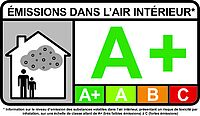
Émissons dans l'air intérieur
Emission-tested building materials and products can make an important contribution to good indoor air quality. The emission label A+ to C is used to identify the emissions of building products and materials for interior design and has its origins in France. Class A+ stands for particularly low-emission products, class C for the highest-emission products.
Product section

Availability
Formats
| Length (mm) | Width (mm) | Thickness (mm) |
|---|---|---|
| 4,100 | 1,300 | 6 | 8 | 10 | 12 | 13 |
Product features
Product standard
- In accordance with EN 438-4
Core material
- Compact laminate black: Uniform black through-pigmented solid compact laminate core, impact resistant and moisture resistant for applications with high specification demands.
Density
- Min. 1,350 kg/m³
Reaction to fire
- Normally flammable
- D-s2,d0 (EN 13501-1, CWFT conforming to 2003/593/EG)
EC scope
- EN 438-7:2005
- Compact laminate intended for internal wall and ceiling finishes (including suspended ceilings)
Formaldehyde emission class
- E1 E05
Antimicrobial effect
- Surface with antimicrobial effect in 24 h for interior fit-out and finishes – Test Methodology JIS Z 2801 / ISO 22196
Product safety
- The surface is physiologically safe, and approved for direct contact with food acc. to Regulation (EU) No. 10/2011.
- This product follows the REACH regulation EC 1907/2006 an article. Following Article 7 it does not need to be registered.
- We manufacture the panels without the use of halogens, heavy metals, preservatives, wood protectors or organic solvents.
Special
- Depending on the decor and surface texture, slightly different surface visual impressions can result between cut panels viewed from different angles. This is a result of the production methods and does not constitute a quality defect.
- Due to a low orientation of the lacquered surface the field of application, the conditions of lighting and the decor may cause certain optical effects. This is a result of the production methods and does not constitute a quality defect.
- Especially for large applications, we recommend paying attention to the colour and texture uniformity of the boards and cut products used when further processing and installing and that the production direction is taken into account.
- The smoother the structure and the the darker the decor, the more sensitive it is to stains.
- Due to the black core of the material, minor decorative deviations to other products cannot be avoided.
- For production-related reasons, there may be minor colour variations in the black material core.
- XTreme plus doesn‘t prevent scratches, but allows horizontal application!
- Decor-structure-combination front side = Decor-structure-combination reverse side
- Subsequent oiling (with suitable cooking oil) of the machined edge can reduce machining and wear marks.
- Please note that in everyday use, polishing, scratches and shiny spots may occur due to mechanical stress, which are particularly visible on darker decors. This does not represent a quality defect or a restriction of usability. Rather, it reflects the natural ageing of the surface. The product complies with all requirements of EN 438.
- With PEFC-certification.
Colour and surface match
- Decor, structure and core board all influence the final appearance of the end product.
- Due to the product-specific differences in production technologies, even identical decor/structure/core board combinations can result in slight optical and tactile deviations across different product groups and formats. Such deviations do not constitute a defect.
- The choice of surface structure in particular has a significant influence on the visual impression, the tactile perception as well as the technical characteristics of the product. Thus, the overall impression of a decor can change almost completely depending on the surface structure. Furthermore, mechanical influences on the product surface can lead to a higher contrast optical perception with dark decors.
- To ensure that you always achieve the best results with our products and to clarify any deviations in advance, we will be happy to advise you individually.
Product handling
Processing
- Sufficient conditioning is required prior to installation and assembly. The premises themselves need to be at the normal climatic conditions in which the material will later be used.
- For an optimum result when cutting to size we recommend the following measures:
- Use a universal saw blade with chamfer (WZ/FA), e.g. GlossCut sawblade made by Leitz
- Hollow ground or trapezoidal tooth sawblades with negative tooth angle
- Optimized height adjustment of the sawblade
- Use universal scoring unit
- Use e.g. a pressure bar or pressure strip to prevent vibration of the material
- Work with lower feed rate than for standard laminates - Use a flat, firm surface to saw and drill on.
- Please note that sharp curring and quiet running tools are indispensable for perfect results.
- Drillholes must be countersunk. Through holes must be made oversize.
- Cutouts and inside corners must have a minimum radius of 8 mm to prevent notch stresses and therefore possible subsequent formation of cracks.
- To avoid chatter marks, cutting tools with high true-running are required. The feed rate is to be reduced in edge-corner and interface areas.
- Cut edges and surfaces should be finely re-sanded to improve surface roughness and ease of cleaning and possibly treated with polishing paste.
- It is possible to refinish narrow surfaces:
1. Dry grinding with 120 / 220 / 400 grit
2. Wet grinding with 600 / 1000 / 1500 / 2000 grit
3. Polish with nonwoven disc (6000 grit) and polishing paste - Please note the recommendations of the ICDLI association on the use of HPL compact boards (www.ICDLI.com).
- We recommend carrying out your own tests depending on the respective application and material requirement.
Machines and tools
- Can be worked with carbide (HW) or diamond (DP) tipped tools on conventional woodworking machines.
- Keyhole saws, punches and jars are not suitable.
- Carbide tipped tools are suitable for machining and processing.
Fitting technology
- All conventional removable and non-removable fittings for solid wood and wood materials are suitable.
Installation and assembly
- Sufficient conditioning is required prior to installation. The premises themselves need to be air-conditioned according to the future use.
- Where panels are covered with protective films, these must be removed from both sides of the panel at the same time to avoid warping. Remove the protective film before using the product, six months after delivery at the latest.
- The material is not suitable for areas subject to large fluctuations in temperature and humidity.
- Ensure good rear ventilation and climate equilibrium on both sides in the installed condition. For adequate air circulation the void should be at least 20 mm. It is important to interrupt horizontal substructures as well as the top and bottom ends of the wall panelling so that vertical rear ventilation is possible. Avoid direct fixing on the surface without air gap.
- Make sure that expansion of installed elements is not prevented. Please observe that when panels are combined with other materials their coefficients of expansion may differ.
- Ensure adequate room for movement of the panel material in the installed condition. Panel joints are to be made with oversize joints and throughholes.
- Newly built walls (made of brick or concrete or plastered walls) contain considerable amounts of moisture. Before covering them with panels they must be completely dried out.
- The base may not be moist or unstable. Please make sure that minimum carrying capacity and stability correspond to the usage.
- Protect the substructure against corrosion.
- Avoid direct exposure to heat and any possible dehydration of the surfaces by light- or heat radiation or by air currents from heating- or air conditioning systems.
- Especially for large applications, we recommend paying attention to the colour and texture uniformity of the boards and cut products used when further processing and installing and that the production direction is taken into account.
- Please ensure that the material is processed and fitted correctly and using the best available technology.
- For further information on processing and installation of HPL and compact HPL, please respect the recommendations of ICDLI (www.icdli.com).
Storage, handling and transport
- The material must be stored flat, level and horizontal on clean surfaces at normal climatic conditions (Temperature 18–25 °C, relative humidity 50–65 %).
- Avoid storage in the direct vicinity of thoroughfare gates, e.g. in the area of loading and unloading zones.
- Protect from moisture and wet conditions.
- Avoid direct exposure to heat and any possible dehydration of the surfaces by light- or heat radiation or by air currents from heating- or air conditioning systems.
- Avoid exposure to direct sunshine or UV rays, especially of products covered in film.
- These storage conditions must continue to be ensured after removing panels from the stack.
- Vertical storage is not recommended.
- Please note that incorrect storage, regardless of its duration, may cause irreversible distortion to the sheets.
- Foreign bodies or impurities in the pallet of sheets can lead to impressions and damage to the surface of the board.
- Sheets / boards must not be moved against each other, they should be moved individually by hand or with suction equipment.
- Ensure that sufficiently large and sturdy bases, e.g. pallets, are used for the transportation of stacked sheets. The sheets on the pallet must be secured against slipping.
Health and safety
- Please wear the appropriate personal protective equipment (PPE) when processing and handling.
Cleaning and care
- The surface can be cleaned with water and gentle cleaning agents. To remove stubborn stains, please observe the recommendations in the data sheet "Cleaning of HPL surfaces" (www.icdli.com).
Disposal
- We recommend energy recovery.
Technical downloads
Brochures
Wall charts
You like to learn more?
Please get in touch with us! We look forward to hearing from you.
